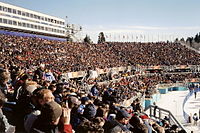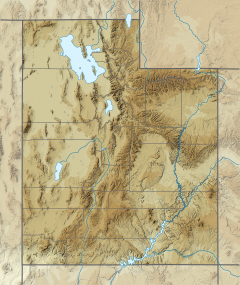|
Snowbasin
Snowbasin Resort is a ski resort in the western United States, located in Weber County, Utah, 33 miles (53 km) northeast of Salt Lake City, on the back (east) side of the Wasatch Range.[1] Opened 86 years ago in 1939,[1] as part of an effort by the city of Ogden to restore the Wheeler Creek watershed, it is one of the oldest continually operating ski resorts in the United States. One of the owners in the early days was Aaron Ross. Over the next fifty years Snowbasin grew, and after a large investment in lifts and snowmaking by owner Earl Holding, Snowbasin hosted the 2002 Winter Olympic alpine skiing races for downhill, combined, and super-G, and is expected to reprise these roles for the 2034 Winter Olympics. The movie Frozen was filmed there in 2009. Snowbasin is located on Mount Ogden at the west end of State Route 226, which is connected to I-84 and SR-39 via SR-167 (New Trappers Loop Road). HistorySnowbasin is one of the oldest continuously operating ski areas in the United States.[2] Following the end of World War I and the Great Depression numerous, small ski resorts were developed in Utah's snow-packed mountains, and Weber County wanted one of their own. They decided to redevelop the area in and around Wheeler Basin, a deteriorated watershed area that had been overgrazed and subjected to aggressive timber-harvesting.[3] Lands were restored and turned over to the U.S. Forest Service, and by 1938 the USFS and Alf Engen had committed to turning the area into a recreational site. The first ski tow was built in 1939 and in service at the new Snow Basin ski park.[3] In 1940, the Civilian Conservation Corps (CCC) crew built the first access road to the new resort, allowing easy access for the general public.[2] In the 1950s, Sam Huntington of Berthoud Pass, Colorado, purchased Snow Basin from the City of Ogden and proceeded to expand the uphill capacity beyond the Wildcat single-seat wooden tower lift and the old rope tow. Overall, he installed a twin chair in place of the rope tow, and a platter-pull tow, later replaced by a twin chair, was installed at Porcupine, to the left of the steep rocky face of Mount Ogden.[4] The fourth NCAA Skiing Championships, the first in Utah, were held at Snow Basin in 1957.[5][6] The downhill race course was set on the right side of the steep face of Mt. Ogden, on the slope named "John Paul Jones", after an early Snow Basin skier. The John Paul Jones' run was only accessible with a 45-minute hike from the top of the Porcupine lift.[4]  Anderl Molterer, of the Austrian national ski team competing there that weekend, approached Huntington and told him if a lift was built directly to the top of the John Paul Jones run, he would bring his world famous Austrian team to Snow Basin to train on it. Molterer said John Paul was the best downhill run in the world. Huntington ignored this proposal, and a lift to the top of John Paul would not be built until Snowbasin received the rights to hold the alpine speed events for the 2002 Winter Olympics. Huntington was killed five years later in 1962, as he was performing post-season maintenance, replacing an electrical fuse at the Porcupine lift.[4][7] Several Ogden businessmen purchased Snow Basin from the Huntington family. Another major personality to come out of Snow Basin was M. Earl Miller, who ran the ski school from the mid-1950s until 1987. Miller played a key role in drafting the Professional Ski Instructors of America (PSIA) American Ski Technique in 1961. Pete Seibert, founder of Vail, led a partnership which bought Snow Basin in 1978,[8][9] but ran into financial difficulty in 1984. The area was sold that October to Earl Holding, owner of Sun Valley in Idaho, and it became "Snowbasin".[10][11][12][13] 2002 Winter Olympics & ParalympicsBecause it was to serve as an Olympic venue site, the U.S. Congress passed the Snowbasin Land Exchange Act in 1996 as part of the Omnibus Lands Bill.[14] The act transferred 1,377 acres (5.57 km2) of National Forest System lands near the resort to the private ownership of Snowbasin, and identified a set of projects that were necessary for the resort to host the Olympic events.[2] Six years earlier in 1990, a similar swap had been denied by the U.S. Forest Service.[15] These projects allowed Snowbasin to double in size in 1998 with new terrain expansions onto Allen Peak to the north and Strawberry and DeMoisy Peaks to the south. During the 2002 Olympics, Snowbasin hosted the downhill, combined (downhill and slalom), and super-G events. The spectator viewing areas consisted of a stadium at the foot of the run, with two sections of snow terraces for standing along both sides of the run.[16] The spectator capacity was 22,500 per event; 99.1 percent of tickets were sold, and 124,373 spectators were able to view events at the Snowbasin Olympic venue.[17] During the 2002 Winter Paralympics, Snowbasin hosted the Alpine Skiing events, including downhill, super-G, slalom, and giant slalom.[18] StatisticsMountain information at the 2002 Winter Olympics
Trails
Lifts
Death
Winter season
Summer season
References
External linksWikimedia Commons has media related to Snowbasin.
|
||||||||||||||||||||||||||||||||||||||



